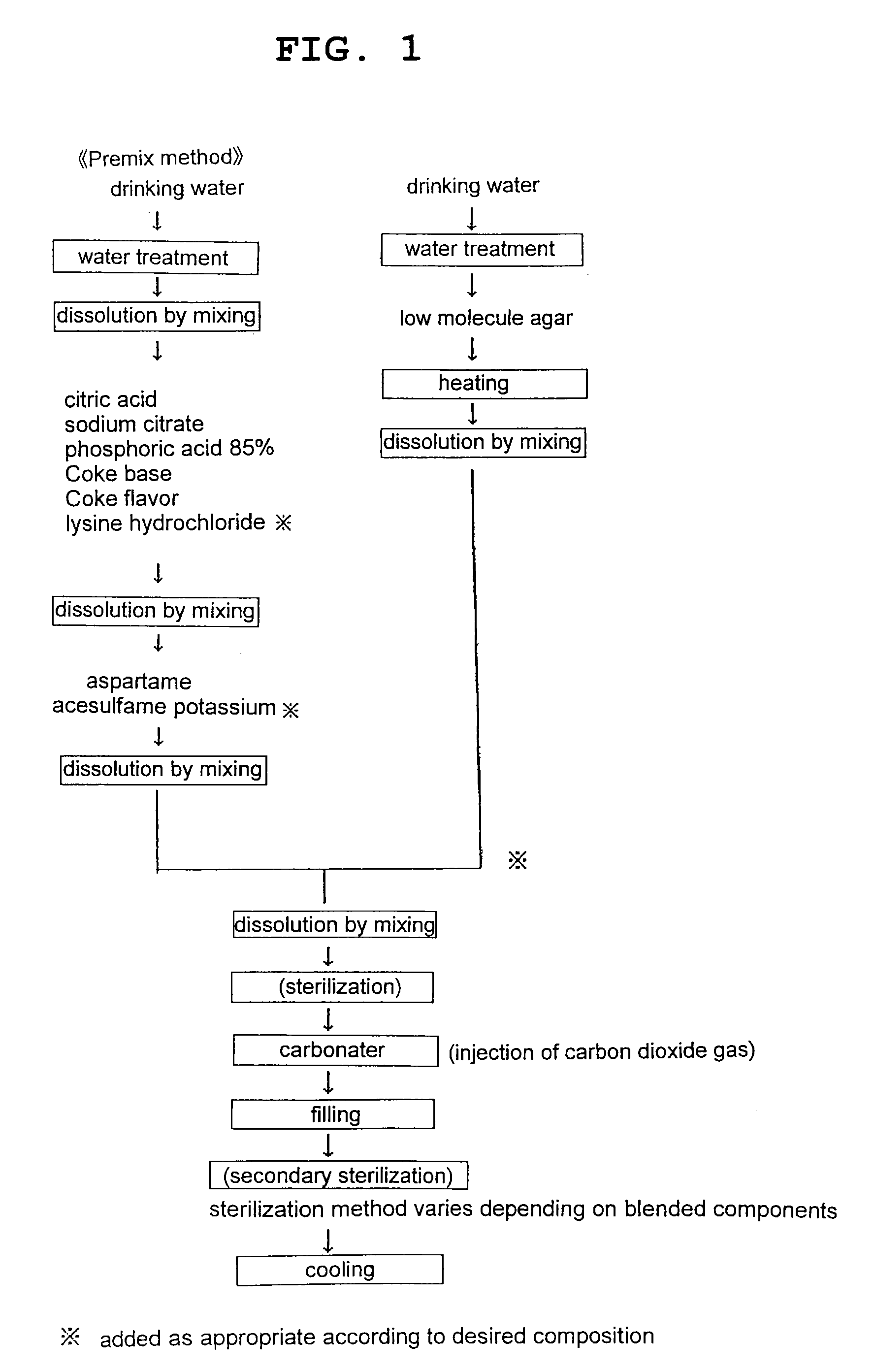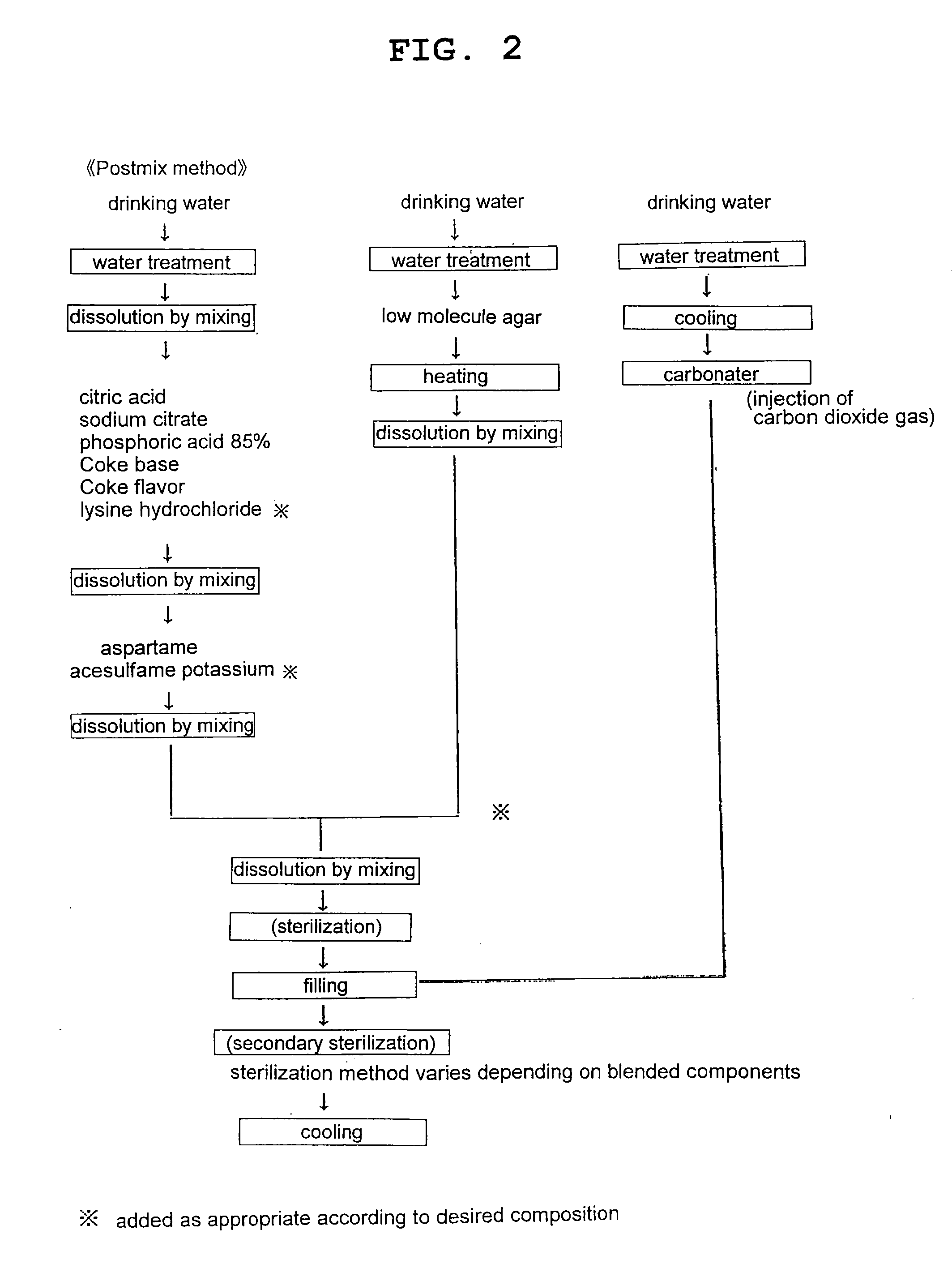Carbonated beverage and method of producing carbonated beverage
a carbonated beverage and beverage technology, applied in the field of high-intensity sweeteners containing carbonated beverages, can solve the problems of poor taste, poor taste of food containing high-intensity sweeteners such as aspartame and the like, and achieve the effect of high effect, specific taste, and improved taste fullness
- Summary
- Abstract
- Description
- Claims
- Application Information
AI Technical Summary
Benefits of technology
Problems solved by technology
Method used
Image
Examples
example 1
Preparation of Coke Carbonated Beverage Containing Aspartame and Lysine Hydrochloride
[0053]The blending compositions are shown in Table 1 and Table 2.
[0054]The preparation steps of Coke carbonated beverages are as follows. (1) Total starting material is measured and mixed. (2) Only the samples wherein lysine hydrochloride was added to an aspartame product (hereinafter to be referred to as APM product) are adjusted to pH 3.08 with phosphoric acid (same value as APM product). (3) Each sample (800 g) is placed in a soda siphon. (4) The soda siphon is cooled with ice water for about 1 hour. (5) Carbon dioxide gas (8 g) is injected into the soda siphon and a lid is put on the siphon. (6) The soda siphon is cooled overnight in a refrigerator. (7) The lid is removed from the soda siphon, about 150 g of the content of the siphon is dispensed to a can and the can is sealed. The inner gas pressure of the carbonated beverage thus prepared is 3 kgf / cm2 to 4 kgf / cm2 when measured at 20° C.
TABLE ...
example 2
Preparation of Coke Carbonated Beverage Containing Aspartame and Low Molecular Weight Agar
[0062]The blending compositions are shown in Table 4. The preparation steps of Coke carbonated beverages were similar to those of Example 1. The low molecular weight agar has effects of weakening the later sweetness of aspartame, imparting fullness, and providing a flavor closer to that of sugar.
example 3
Preparation of Coke Carbonated Beverage Containing Aspartame, Lysine Hydrochloride and Low Molecular Weight Agar
[0063]The blending compositions are shown in Table 4. The preparation steps of Coke carbonated beverages were similar to those of Example 1. The combination of lysine hydrochloride and low molecular weight agar provides effects of weakening the later sweetness of aspartame, imparting fullness, intensifying the early sweetness, and providing a flavor closer to that of sugar.
TABLE 4Compositions of Coke carbonated beverages (samples).samplelow molecule agar,low molecule agarlysine hydrochloridestarting materialsadded productadded productaspartame0.07290.0729citric acid0.0250.025sodium citrate0.010.01phosphoric acid 85%0.030.03Coke base *10.200.20Coke flavor *20.100.10lysine—0.10hydrochloridelow molecule agar *30.050.05ion exchange waterbalancebalancetotal100100In Table, the unit is (g).*1 Takasago International Corporation, Coke base W-6521*2 Takasago International Corporatio...
PUM
 Login to View More
Login to View More Abstract
Description
Claims
Application Information
 Login to View More
Login to View More - R&D
- Intellectual Property
- Life Sciences
- Materials
- Tech Scout
- Unparalleled Data Quality
- Higher Quality Content
- 60% Fewer Hallucinations
Browse by: Latest US Patents, China's latest patents, Technical Efficacy Thesaurus, Application Domain, Technology Topic, Popular Technical Reports.
© 2025 PatSnap. All rights reserved.Legal|Privacy policy|Modern Slavery Act Transparency Statement|Sitemap|About US| Contact US: help@patsnap.com


